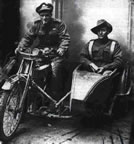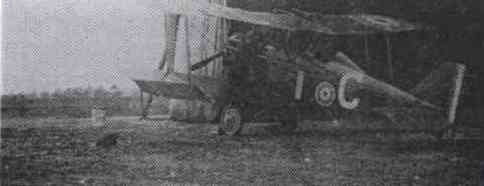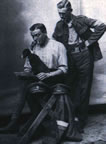World war I
The Great War, which lasted from 1914 to 1918, involved the participation of several countries. The conflict expanded across Europe. The expression "Der des Ders" spread in France at the end of hostilities, such as the last one ending all wars.
- Local situation
- Behind the front lines
- Key dates
![]()
Local situation
Nearly a million people were killed, nearly three million were injured, and millions of hectares were devastated by the bombings. A wounded evacuation zone was based at Vignacourt, under the tents. The objective was to provide first aid close to the front lines, to reduce pain, or even to support the last moments of the most complex cases. The field hospital cared for the seriously injured, but the railway allowed the transfer of wounded soldiers to be treated in specialized hospitals. The convalescents stayed a few days to recover strength before setting out on the battlefields.
The airfield was just a few meters away, marked with a ground guide to direct the planes. Backfilling works carried out after the war were reported in a daily newspaper of the time; the trenches around the village seemed quite large.
Soldiers of different nationalities passed through the village, including Americans, Australians, Canadians, Chinese, French, Germans, Indians, Irish, Italians, and Moroccans.









Louis Thuillier photos
Behind the front line in the canton
The noise of cannons could be heard in the surrounding villages all night until morning, sometimes in a ceaseless way. Flares and bombs seen in the distance followed one another in the night.
The newspapers brought daily news from the front, such as the movement of troops, the advance, or the retreat of the units. The Allies provided information concerning aircraft not returned to their base. When the weather was too bad, they stayed on the ground.
In the mail, we hoped to find a card from the husband or son stating he was in good health and thought he would be back in the next few days. Sometimes, cards with the battalion's photo were sent. Anxiety increased when the news was slow to arrive and was not always positive.
The authorities filtered the mail to avoid leaks of strategic information or bad news for the soldiers' morale. The allies had exchanged a few letters with the inhabitants they had already met to inquire about the atest news from the region. Dispatches distributed in the factories and stations were forged because they could fall into the hands of the enemy.
Each soldier returning on leave conveyed information to the family of a comrade wounded in combat or the position in the trenches for those who had remained at the front.
This moment of respite was used to see loved ones, get news from neighbors, rest, and enjoy good meals.
Gardens were cultivated when possible. Vegetables were staple foods when meat was too expensive. The fruits harvested were used to make jam to send to the soldiers at the front. (plums, peaches, apples, etc.)
In the streets of the villages, there were constant comings and goings of cannons, supplies, the passage of troops, and artillery batteries.
All this information is based on real facts written during the war.
Key dates
1914 - 28th June: Assassination of Archduke Franz Ferdinand - The Sarajevo attack.
1914 - 02 August: French mobilization.
1914 - 5th Sept to 12th Sept: Battle of the Marne.
1914 - October 12 to November 2: Battle of Mesen - Messines
1914 - 19th Oct to 24th Nov 1914 -1st Battle of Ypres or Battle of Flanders in Belgium.
1915 - February, 1915 to January, 1916 - Gallipoli campaign
1915 - 10th - 13th March - Battle of Neuve-Chapelle.
1915 - April 22 to May 25, 1915 - Second Battle of Ypres.
1915 - 23 May: entry into the War of Italy.
1915 - 6th to 16th June: Battle of Quennevières. (Oise).
1916 - 21st Feb to 19th Dec: Battle of Verdun.
1916 - May 31 to June 1: The Battle of Jutland, called "Skagerrak" in German, is the most significant naval battle in history. Battleships, cruisers, and torpedo boats of the British and German fleets confronted Denmark. It caused many victims on the German and British sides. Admiral Jellicoe, called Jack by relatives, remained master of the battlefield and maintained England's strategic position. He then served as Governor General of New Zealand from 1920 to 1924.
1916 - June 2 to 14: Battle of Mount Sorrel - Battle of Hill 62 in Belgium.
1916 - 1st July to Nov 18th: Battle of the Somme.
1916 - 19 to 20 July: Battle of Fromelles.
1916 - 1st Oct to 11 Nov 1916 - Ancre (Albert)
1917 - 4 to 12 April: Battle of Sapigneul in the Aisne near Berry-au-Bac.
1917 - 6th April: The United States declared war on Germany.
1917 - 9th April: Battle of Arras.
1917 - 9 to 12 April: Battle of Vimy Ridge. April 9 was the bloodiest day of the war for the Canadian Corps.
1917 - May 3: Second Battle of Bullecourt.
1917 - 16th April to 24th Oct: Battle of Chemin des dames (2nd Battle of the Aisne).
1917 - June 7 to 14: 2nd Battle of Mesen - Messines.
1917 - July 31 and November 6, 1917: Battle of Passchendaele or 3rd Battle of Ypres.
1917 - 20 Nov to 7 December: The Battle of Cambrai.
1918 - 27th May to 6 August: 2nd battle of the Marne.
1918 - March 21th to April 5th: Operation Michael.
1918 - 9th to 29th April 1918: Battle of the Lys or 4th battle of Ypres (Estaires).
1918 - 28th to 31 May 1918: Battle of Cantigny.
1918 - August 8th to 12th: Battle of Amiens.
1918 - 21th August to 1st September - Battle of Bapaume.
1918 - August 31 to Sept 3st: Mont Saint-Quentin.
1918 - Nov 11th: Signing of Armistice.
1919 - June 28th: The treaty of Versailles, in the Hall of Mirrors.

General mobilization poster
